Surface Urban Heat Island Risk Index Computation Using Remote-Sensed Data and Meta Population Dataset on Naples Urban Area (Italy)
Highlights
- The use of a freely accessible satellite through a data remote computing platform reduces hardware and software requirements.
- The method includes the integration of population-related information (welfare and other statistical information) and Local Climate Zone (LCZ) classification.
- The use of long historical data series ensures more robust analysis over time, identifying areas most susceptible to extreme thermal events.
- This study may provide hints for the relevant authorities in terms of the sustainable development of cities, supporting pollution reduction.
Abstract
1. Introduction
1.1. Aim of the Work
1.2. Study Area
2. Materials and Methods
2.1. Data
2.1.1. Satellite Data
2.1.2. Emissivity Data
2.1.3. Atmospheric Correction
2.1.4. Population Dataset
2.2. Processing
2.3. Risk Evaluation
2.3.1. Exposure
2.3.2. Hazard
2.3.3. Vulnerability
3. Results
3.1. Local Climate Zones
3.2. Risk Indices with Reference to Each Population Category Distribution
3.3. Risk Indices Referring to the LST
4. Discussion and Conclusions
Author Contributions
Funding
Data Availability Statement
Acknowledgments
Conflicts of Interest
Correction Statement
References
- Seneviratne, S.I.; Zhang, X.; Adnan, M.; Badi, W.; Dereczynski, C.; Di Luca, A.; Ghosh, S.; Iskander, I.; Kossin, J.; Lewis, S.; et al. Weather and Climate Extreme Events in a Changing Climate. In Climate Change 2021: The Physical Science Basis. Contribution of Working Group I to the Sixth Assessment Report of the Intergovernmental Panel on Climate Change; Masson-Delmotte, V., Zhai, P., Pirani, A., Connors, S.L., Péan, C., Berger, S., Caud, N., Chen, Y., Goldfarb, L., Gomis, M.I., et al., Eds.; Cambridge University Press: Cambridge, UK; New York, NY, USA, 2021; pp. 1513–1766. [Google Scholar] [CrossRef]
- Yang, M.; Ren, C.; Wang, H.; Wang, J.; Feng, Z.; Kumar, P.; Cao, S.J. Mitigating urban heat island through neighboring rural land cover. Nat. Cities 2024, 1, 522–532. [Google Scholar] [CrossRef]
- Shepherd, T.G. Atmospheric circulation as a source of uncertainty in climate change projections. Nat. Geosci. 2014, 7, 703–708. [Google Scholar] [CrossRef]
- IPCC. Sections. In Climate Change 2023: Synthesis Report. Contribution of Working Groups I, II and III to the Sixth Assessment Report of the Intergovernmental Panel on Climate Change; Core Writing Team, Lee, H., Romero, J., Eds.; IPCC: Geneva, Switzerland, 2023; pp. 35–115. [Google Scholar] [CrossRef]
- Masselot, P.; Mistry, M.N.; Rao, S.; Huber, V.; Monteiro, A.; Samoli, E.; Gasparrini, A. Estimating future heat-related and cold-related mortality under climate change, demographic and adaptation scenarios in 854 European cities. Nat. Med. 2025, 31, 1294–1302. [Google Scholar] [CrossRef]
- García-Herrera, R.; Díaz, J.; Trigo, R.M.; Luterbacher, J.; Fischer, E.M. A review of the European summer heat wave of 2003. Crit. Rev. Environ. Sci. Technol. 2010, 40, 267–306. [Google Scholar] [CrossRef]
- Ebi Kristie, L.; Gerald, M. The heat is on: Climate change and heatwaves in the midwest. In Regional Impacts of Climate Change: Four Case Studies in the United States; Pew Center on Global Climate Change: Washington, DC. USA, 2007; Available online: https://n2t.org/ark:/85065/d79w0gvw (accessed on 5 September 2025).
- Mayrhuber, E.A.-S.; Dückers, M.L.; Wallner, P.; Arnberger, A.; Allex, B.; Wiesböck, L.; Wanka, A.; Kolland, F.; Eder, R.; Hutter, H.-P.; et al. Vulnerability to heatwaves and implications for public health interventions—A scoping review. Environ. Res. 2018, 166, 42–54. [Google Scholar] [CrossRef]
- Changnon; Stanley, A.; Kunkel, K.E.; Reinke, B.C. Impacts and responses to the 1995 heat wave: A call to action. Bull. Am. Meteorol. Soc. 1996, 77, 1497–1506. [Google Scholar] [CrossRef]
- Palecki, M.A.; Changnon, S.A.; Kunkel, K.E. The Nature and Impacts of the July 1999 Heat Wave in the Midwestern United States: Learning from the Lessons of 1995. Bull. Am. Meteorol. Soc. 2001, 82, 1353–1367. [Google Scholar] [CrossRef]
- Althor, G.; Watson, J.E.M.; Fuller, R.A. Global mismatch between greenhouse gas emissions and the burden of climate change. Sci. Rep. 2016, 6, 20281. [Google Scholar] [CrossRef]
- Li, X.; Zhou, Y.; Yu, S.; Jia, G.; Li, H.; Li, W. Urban heat island impacts on building energy consumption: A review of approaches and findings. Energy 2019, 174, 407–419. [Google Scholar] [CrossRef]
- Filonchyk, M.; Peterson, M.P.; Zhang, L.; Hurynovich, V.; He, Y. Greenhouse gases emissions and global climate change: Examining the influence of CO2, CH4, and N2O. Sci. Total. Environ. 2024, 935, 173359. [Google Scholar] [CrossRef]
- Morabito, M.; Crisci, A.; Guerri, G.; Messeri, A.; Congedo, L.; Munafò, M. Surface urban heat islands in Italian metropolitan cities: Tree cover and impervious surface influences. Sci. Total. Environ. 2021, 751, 142334. [Google Scholar] [CrossRef]
- Magli, S.; Lodi, C.; Lombroso, L.; Muscio, A.; Teggi, S. Analysis of the urban heat island effects on building energy consumption. Int. J. Energy Environ. Eng. 2015, 6, 91–99. [Google Scholar] [CrossRef]
- Wei, L.; Sobrino, J.A. Surface urban heat island analysis based on local climate zones using ECOSTRESS and Landsat data: A case study of Valencia city (Spain). Int. J. Appl. Earth Obs. Geoinf. 2024, 130, 103875. [Google Scholar] [CrossRef]
- Pearsall, H. Staying cool in the compact city: Vacant land and urban heating in Philadelphia, Pennsylvania. Appl. Geogr. 2017, 79, 84–92. [Google Scholar] [CrossRef]
- Kim, J.; Lee, D.-K.; Brown, R.D.; Kim, S.; Kim, J.-H.; Sung, S. The effect of extremely low sky view factor on land surface temperatures in urban residential areas. Sustain. Cities Soc. 2022, 80, 103799. [Google Scholar] [CrossRef]
- Deng, X.; Yu, W.; Shi, J.; Huang, Y.; Li, D.; He, X.; Zhou, W.; Xie, Z. Characteristics of surface urban heat islands in global cities of different scales: Trends and drivers. Sustain. Cities Soc. 2024, 107, 105483. [Google Scholar] [CrossRef]
- Zhang, W.; Zheng, C.; Chen, F. Mapping heat-related health risks of elderly citizens in mountainous area: A case study of Chongqing, China. Sci. Total Environ. 2019, 663, 852–866. [Google Scholar] [CrossRef]
- Ballester, J.; Quijal-Zamorano, M.; Turrubiates, R.F.M.; Pegenaute, F.; Herrmann, F.R.; Robine, J.M.; Basagaña, X.; Tonne, C.; Antó, J.M.; Achebak, H. Heat-related mortality in Europe during the summer of 2022. Nat. Med. 2023, 29, 1857–1866. [Google Scholar] [CrossRef]
- Available online: https://www.un.org/development/desa/en/news/population/2018-revision-of-world-urbanization-prospects.html (accessed on 5 September 2025).
- Gauer, R.; Meyers, B.K. Heat-related illnesses. Am. Fam. Physician 2019, 99, 482–489. [Google Scholar]
- Crichton, D. The Risk Triangle; Tudor Rose: London, UK, 1999. [Google Scholar]
- Buscail, C.; Upegui, E.; Viel, J.F. Mapping heatwave health risk at the community level for public health action. Int. J. Health Geogr. 2012, 11, 38. [Google Scholar] [CrossRef]
- Chen, Q.; Ding, M.; Yang, X.; Hu, K.; Qi, J. Spatially explicit assessment of heat health risk by using multi-sensor remote sensing images and socioeconomic data in Yangtze River Delta, China. Int. J. Health Geogr. 2018, 17, 15. [Google Scholar] [CrossRef]
- Baker, C.J.; Thornes, J.E.; Chapman, L.; Tomlinson, C.J. Including the urban heat island in spatial heat health risk assessment strategies: A case study for Birmingham, UK. Int. J. Health Geogr. 2011, 10, 42. [Google Scholar] [CrossRef]
- Scalabrini, A.; Musacchio, M.; Silvestri, M.; Rabuffi, F.; Buongiorno, M.F.; Salvini, F. Satellite Time-Series Analysis for Thermal Anomaly Detection in the Naples Urban Area, Italy. Atmosphere 2014, 15, 523. [Google Scholar] [CrossRef]
- Gaudioso, D.; Giordano, F.; Taurino, E. Focus Sulle Città e la Sfida dei Cambiamenti Climatici; ISPRA: Rome, Italy, 2014. [Google Scholar]
- Orusa, T.; Viani, A.; Moyo, B.; Cammareri, D.; Borgogno-Mondino, E. Risk assessment of rising temperatures using landsat 4–9 LST time series and meta® population dataset: An application in Aosta Valley, NW Italy. Remote Sens. 2023, 15, 2348. [Google Scholar] [CrossRef]
- Li, Z.L.; Wu, H.; Wang, N.; Qiu, S.; Sobrino, J.A.; Wan, Z.; Tang, B.H.; Yan, G. LSE retrieval from satellite data. Int. J. Remote Sens. 2013, 34, 3084–3127. [Google Scholar] [CrossRef]
- Ermida, S.L.; Soares, P.; Mantas, V.; Gottsche, F.; Trigo, I. Google Earth Engine Open-Source Code for Land Surface Temperature Estimation from the Landsat Series. Remote Sens. 2020, 12, 1471. [Google Scholar] [CrossRef]
- Landsat 8. Available online: https://landsat.gsfc.nasa.gov/landsat-8/ (accessed on 30 November 2023).
- USGS. Landsat 8 OLI and TIRS Calibration Notices. Available online: https://www.usgs.gov/land-resources/nli/landsat/landsat-8-oli-and-tirs-calibration-notices (accessed on 30 November 2023).
- Duan, S.B.; Li, Z.L.; Wang, C.; Zhang, S.; Tang, B.H.; Leng, P.; Gao, M.F. Land-surface temperature retrieval from Landsat 8 single-channel thermal infrared data in combination with NCEP reanalysis data and ASTER GED product. Int. J. Remote Sens. 2019, 40, 1763–1778. [Google Scholar] [CrossRef]
- Available online: https://data.humdata.org/organization/74ad0574-923d-430b-8d52-ad80256c4461 (accessed on 5 September 2025).
- Available online: https://dataforgood.facebook.com/dfg/docs/high-resolution-population-density-maps-demographic-estimates-documentation (accessed on 5 September 2025).
- Hulley, G.; Hook, S. The Aster Global emissivity database. Geophys. Res. Lett. 2015, 42, 7966–7976. [Google Scholar] [CrossRef]
- ASTER Global Emissivity Dataset GED. Available online: https://lpdaac.usgs.gov/products/ag100v003/ (accessed on 30 November 2023).
- Verhulst, S.; Ramesh, A.; Young, A.; Zahuranec, A.J. Where Is Everyone? The Importance of Population Density Data: A Data Artefact Study of the Facebook Population Density Map; Elsevier: Amsterdam, The Netherlands, 2021. [Google Scholar]
- Facebook Connectivity Lab and Center for International Earth Science Information Network—CIESIN—Columbia University. High Resolution Settlement Layer (HRSL); Palgrave Macmillan: Cham, Switzerland, 2016; Source imagery for HRSL © 2016 DigitalGlobe. [Google Scholar]
- Caputo, T.; Bellucci Sessa, E.; Silvestri, M.; Buongiorno, M.F.; Musacchio, M.; Sansivero, F.; Vilardo, G. Surface temperature multiscale monitoring by thermal infrared satellite and ground images at Campi Flegrei volcanic area (Italy). Remote Sens. 2019, 11, 1007. [Google Scholar] [CrossRef]
- Yoo, C.; Im, J.; Weng, Q.; Cho, D.; Kang, E.; Shin, Y. Diurnal urban heat risk assessment using extreme air temperatures and real-time population data in Seoul. iScience 2023, 26, 108123. [Google Scholar] [CrossRef]
- Guha, S.; Govil, H.; Mukherjee, S. Dynamic analysis and ecological evaluation of urban heat islands in Raipur city, India. J. Appl. Remote Sens. 2017, 11, 036020. [Google Scholar] [CrossRef]
- Available online: https://www.napolitoday.it/cronaca/caldo-allerta-19-20-luglio-2023.html (accessed on 5 September 2025).
- IPCC. Climate Change 2014: Synthesis Report. Contribution of Working Groups I, II and III to the Fifth Assessment Report of the Intergovernmental Panel on Climate Change; Core Writing Team, Pachauri, R.K., Meyer, L.A., Eds.; IPCC: Geneva, Switzerland, 2014; p. 151. [Google Scholar]
- van Daalen, K.R.; Tonne, C.; Semenza, J.C.; Rocklöv, J.; Markandya, A.; Dasandi, N.; Jankin, S.; Achebak, H.; Ballester, J.; Bechara, H.; et al. The 2024 Europe report of the Lancet Countdown on health and climate change: Unprecedented warming demands unprecedented action. Lancet Public Health 2014, 9, e495–e522. [Google Scholar] [CrossRef]
- Fierro, P.; Loria, S.; Duca, P.; Loffredo, L. Sviluppare conoscenza attraverso la partecipazione. Il Referto Epidemiologico Comunale (REC). Recent. Prog. Med. 2022, 113, 749–751. [Google Scholar] [CrossRef]
- Available online: https://www.who.int/health-topics/heatwaves#tab=tab_1 (accessed on 5 September 2025).
- Available online: https://www.eea.europa.eu/en/analysis/publications/the-impacts-of-heat-on-health#:~:text=For%20example%2C%20for%202022%2C%20it,et%20al.%2C%202024) (accessed on 5 September 2025).
- Piano Nazionale di Prevenzione degli Effetti del Caldo Sulla Salute, Linee di Indirizzo per la Prevenzione. 2019. Available online: https://cipesalute.org/cedo/allegati/8520-allegato7519094.pdf (accessed on 17 September 2025).
- Kestens, Y.; Brand, A.; Fournier, M.; Goudreau, S.; Kosatsky, T.; Maloley, M.; Smargiassi, A. Modelling the variation of land surface temperature as determinant of risk of heat-related health events. Int. J. Health Geogr. 2011, 10, 7. [Google Scholar] [CrossRef]
- Pappaccogli, G.; Esposito, A.; Buccolieri, R. Summer Diurnal LST Variability Across Local Climate Zones Using ECOSTRESS Data in Lecce and Milan. Atmosphere 2025, 16, 377. [Google Scholar] [CrossRef]
- Morabito, M.; Crisci, A.; Gioli, B.; Gualtieri, G.; Toscano, P.; Di Stefano, V.; Orlandini, S.; Gensini, G.F. Urban-hazard risk analysis: Mapping of heat-related risks in the elderly in major Italian cities. PLoS ONE 2015, 10, e0127277. [Google Scholar] [CrossRef]
- Feng, W.; Liu, J. A Literature Survey of Local Climate Zone Classification: Status, Application, and Prospect. Buildings 2022, 12, 1693. [Google Scholar] [CrossRef]
- Huang, F.; Jiang, S.; Zhan, W.; Bechtel, B.; Liu, Z.; Demuzere, M.; Huang, Y.; Xu, Y.; Ma, L.; Xia, W.; et al. Mapping local climate zones for cities: A large review. Remote Sens. Environ. 2023, 292, 113573. [Google Scholar] [CrossRef]
- Bechtel, B.; Alexander, P.J.; Böhner, J.; Ching, J.; Conrad, O.; Feddema, J.; Mills, G.; See, L.; Stewart, I. Mapping local climate zones for a worldwide database of the form and function of cities. ISPRS Int. J. Geo-Inf. 2015, 4, 199–219. [Google Scholar] [CrossRef]
- Stewart, I.D.; Oke, T.R. Local climate zones for urban temperature studies. Bull. Am. Meteorol. Soc. 2012, 93, 1879–1900. [Google Scholar] [CrossRef]
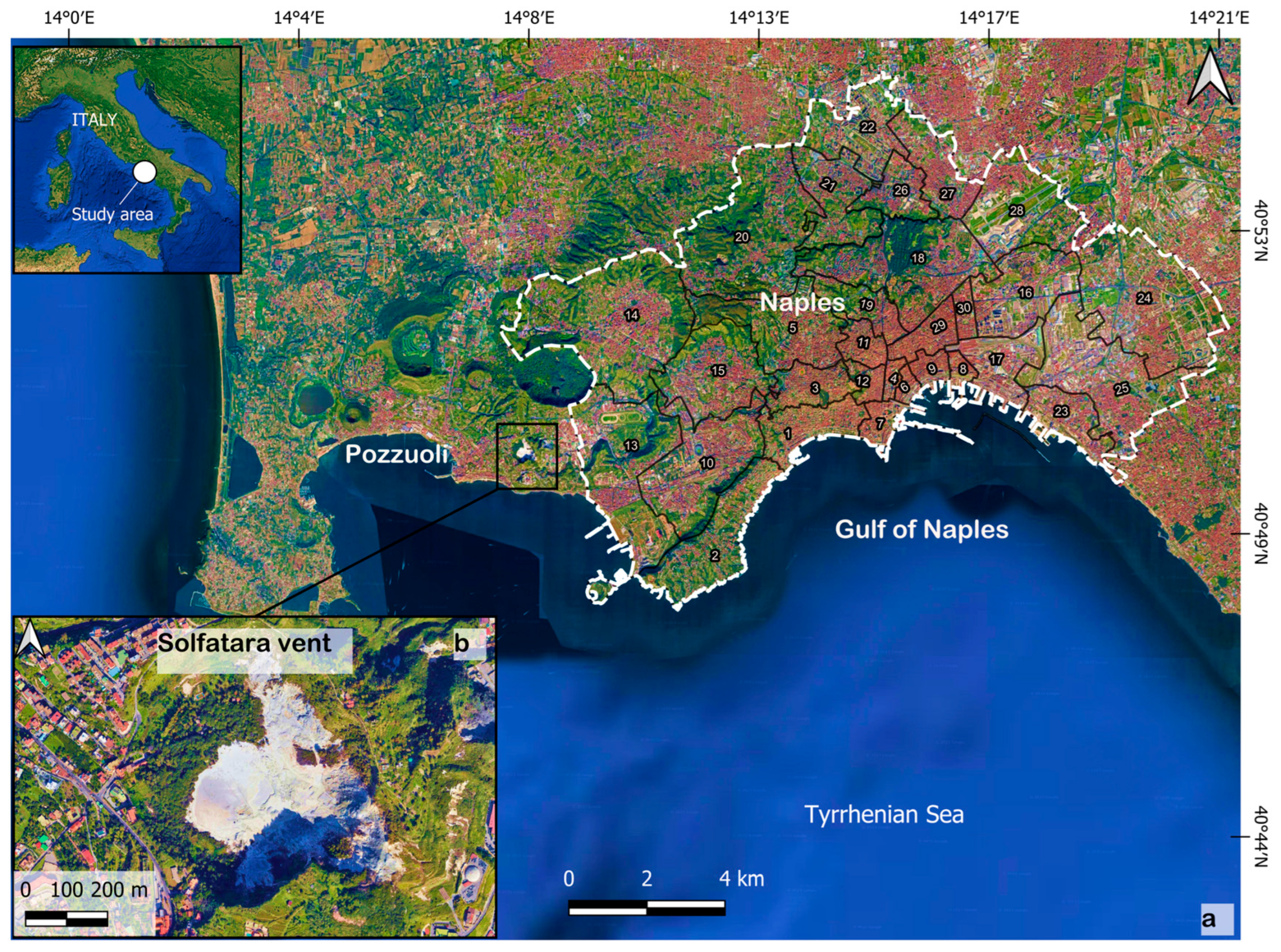
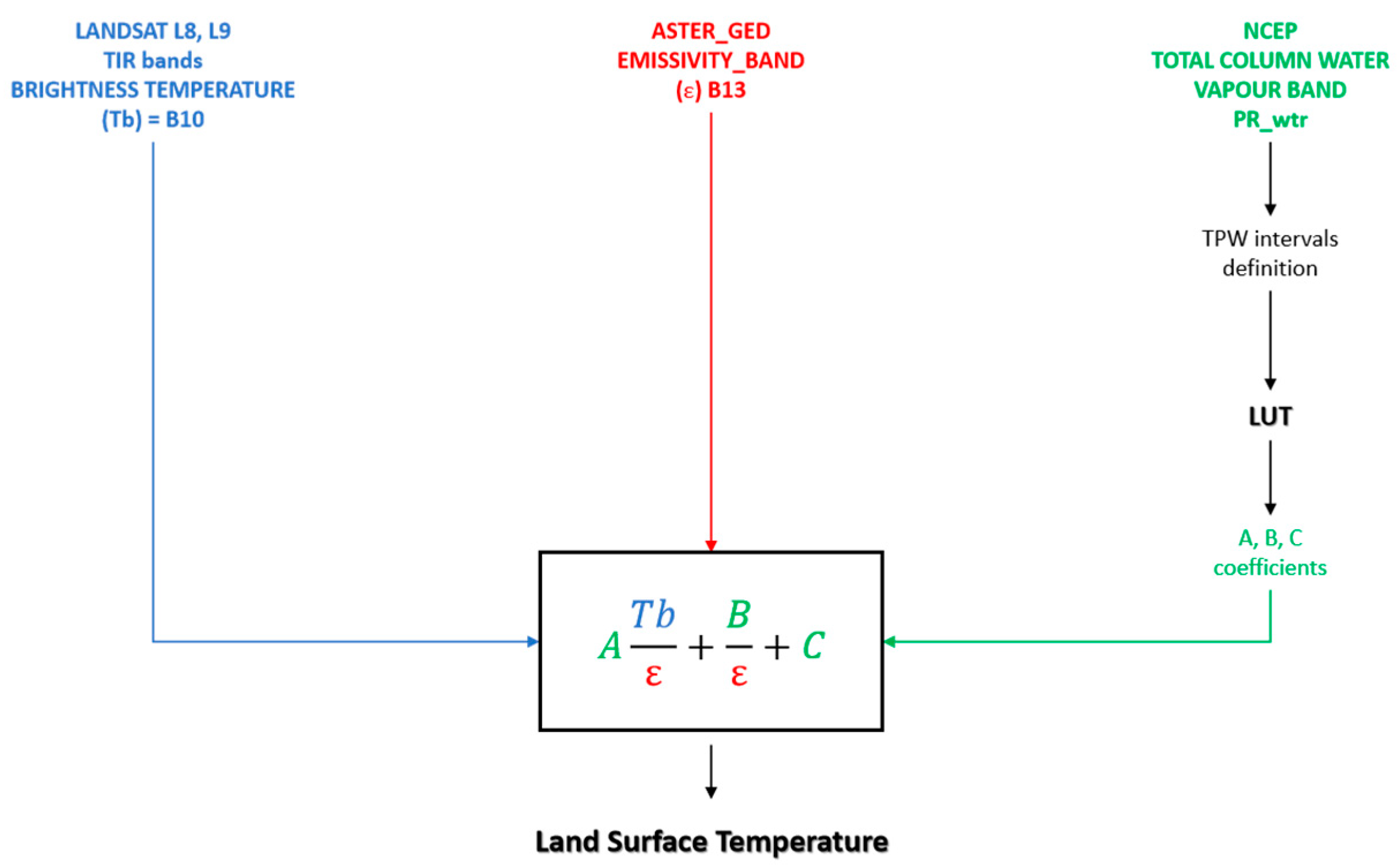

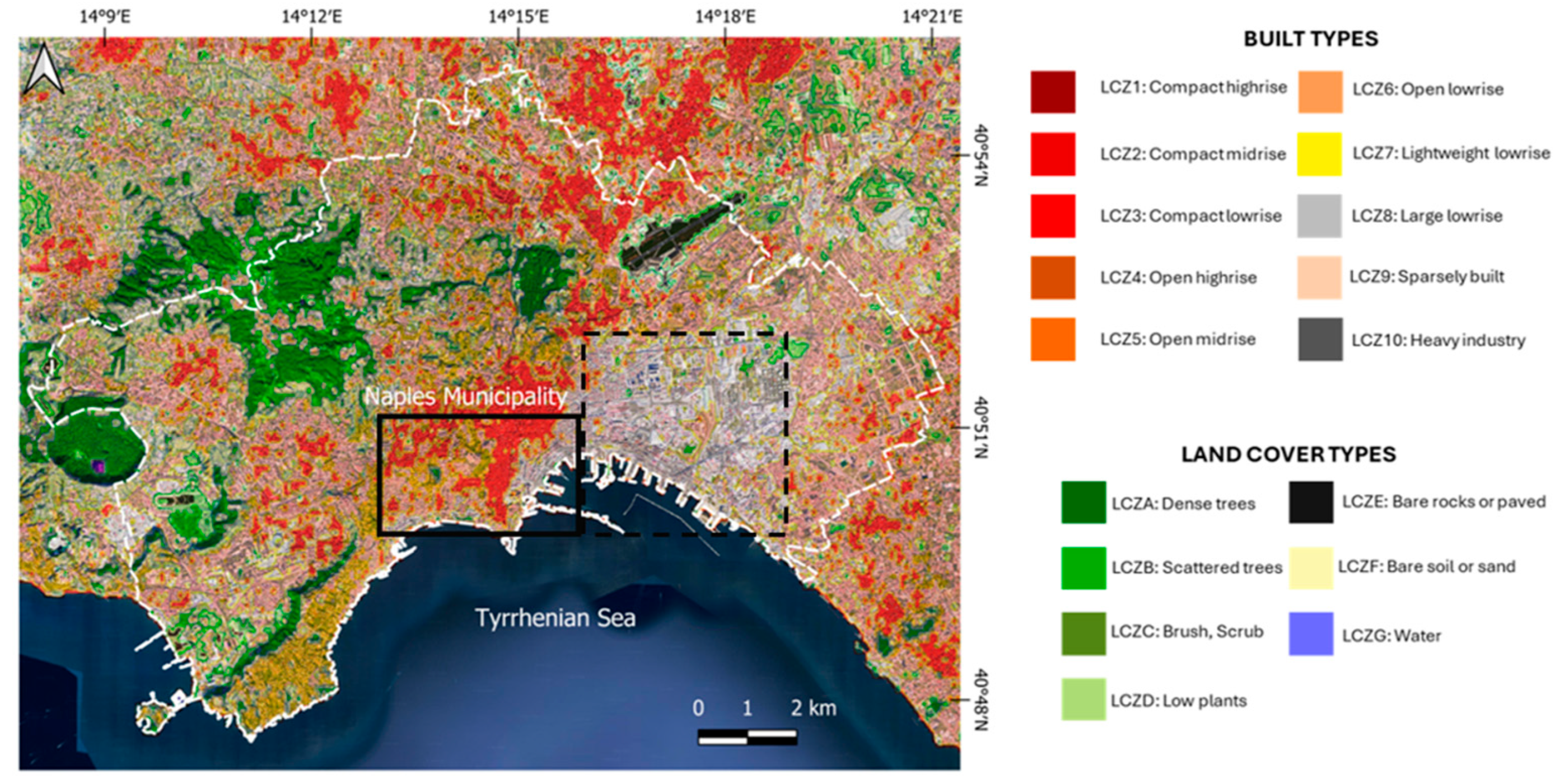
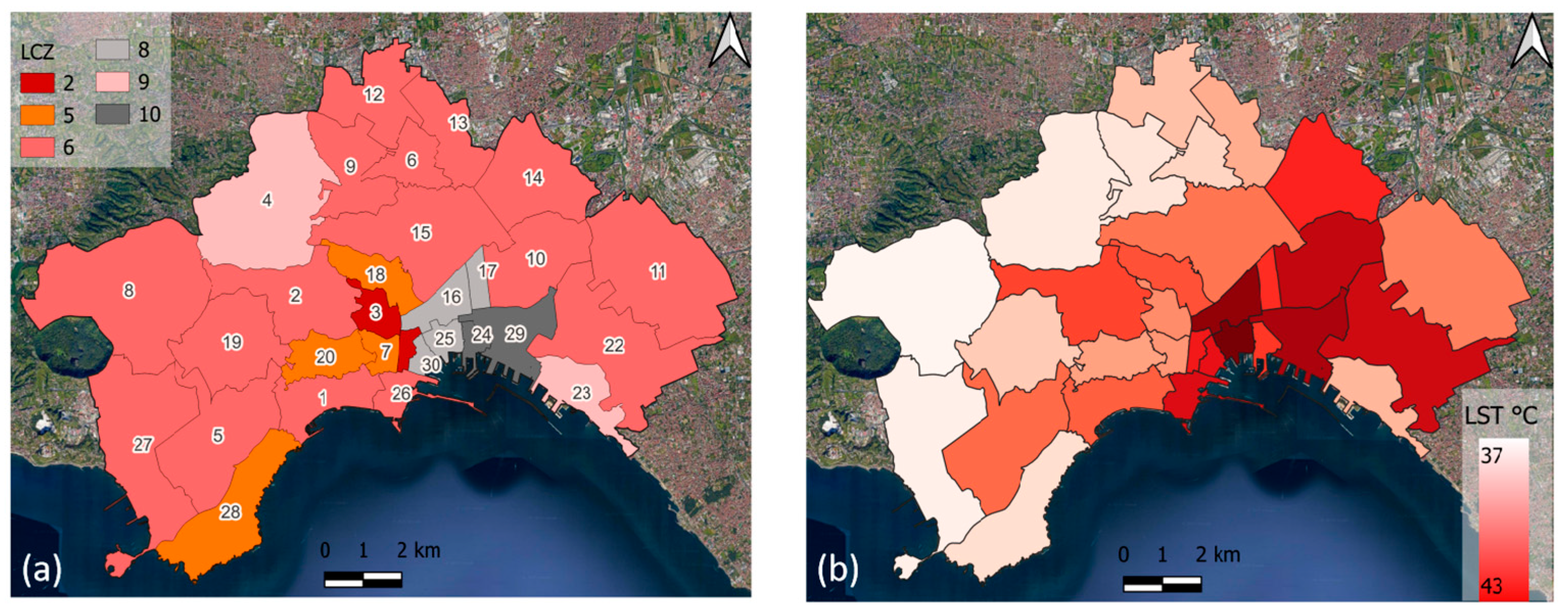

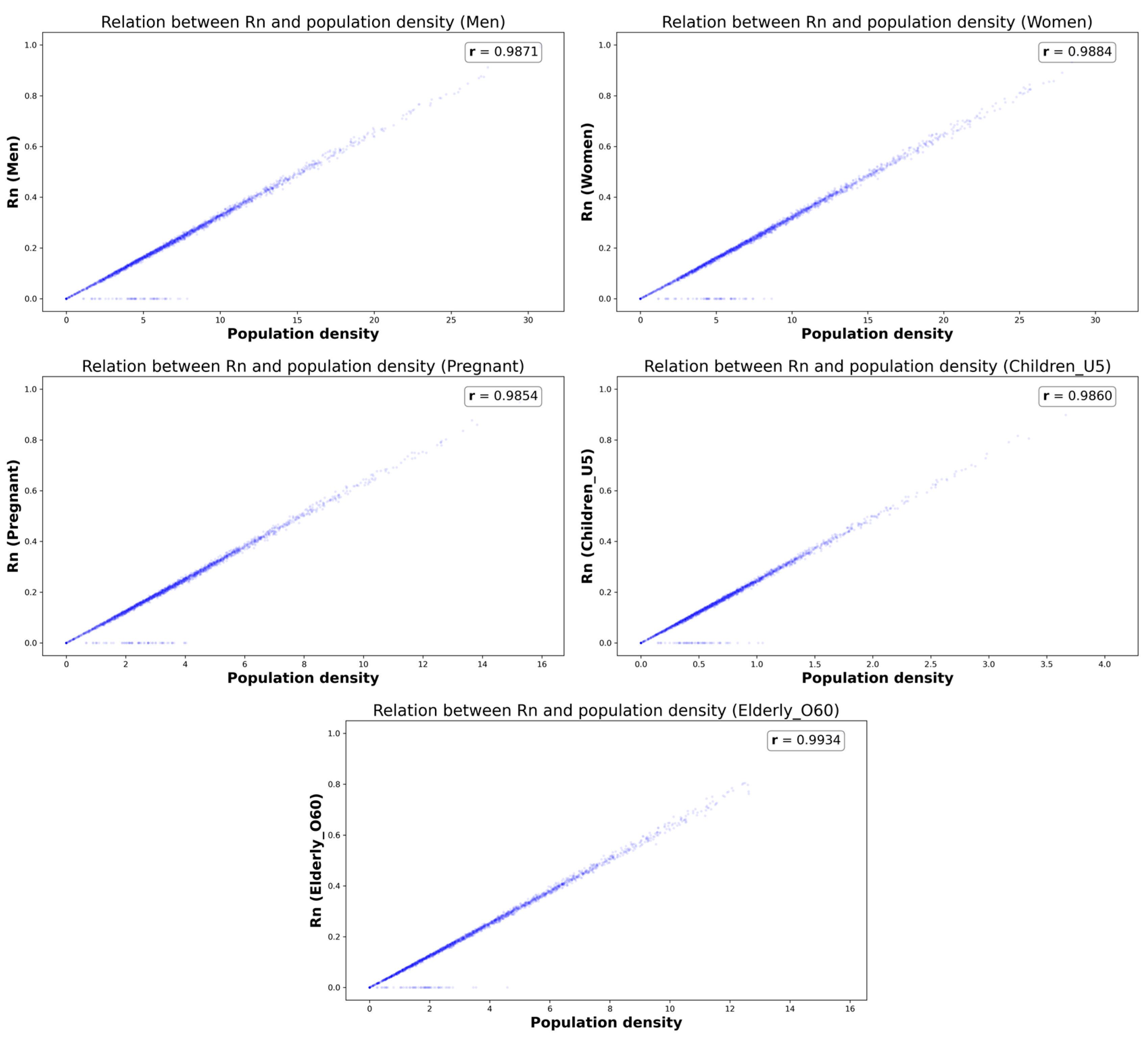
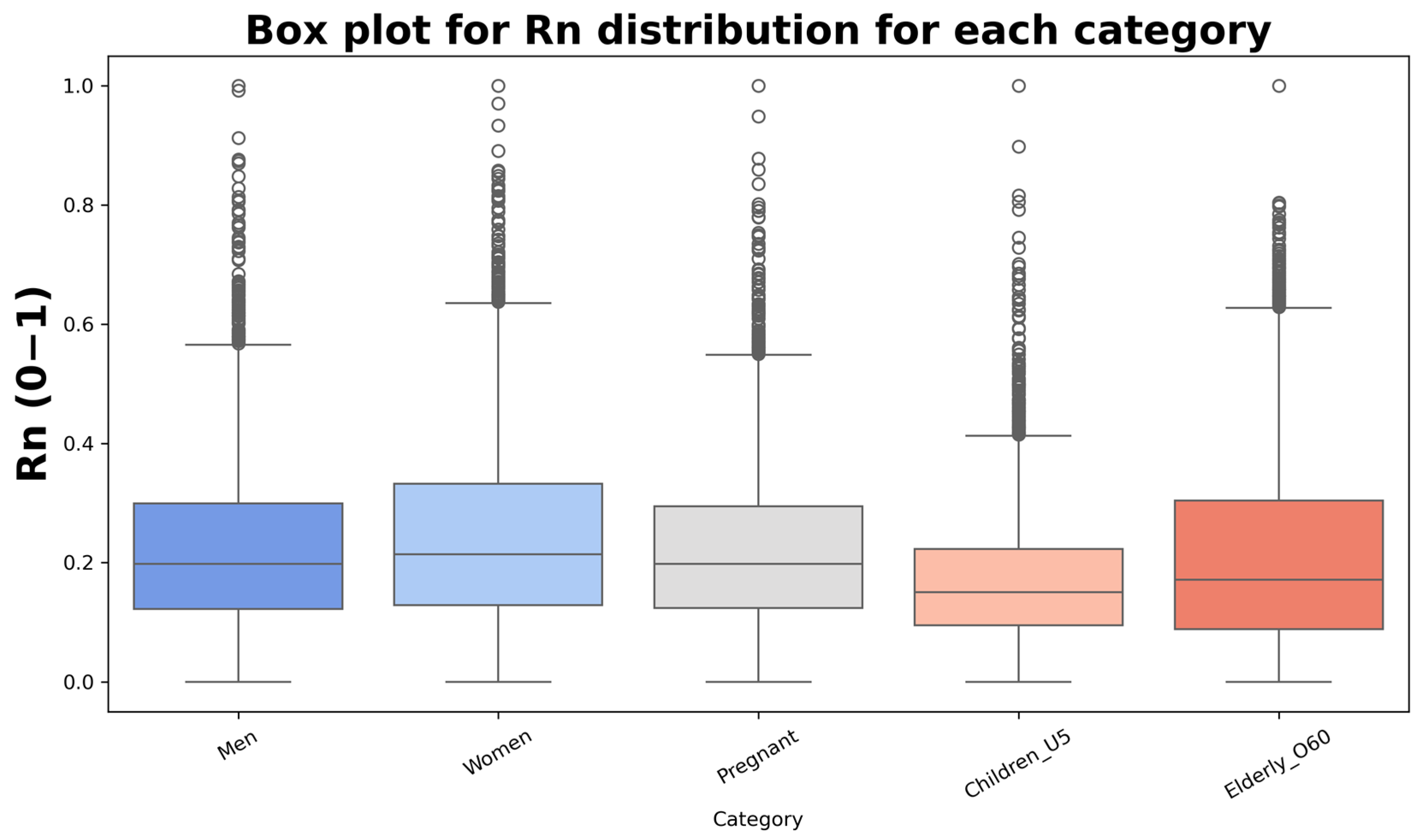

| Neighborhood | Numbers | Neighborhood | Numbers | Neighborhood | Numbers |
|---|---|---|---|---|---|
| Chiaia | 1 | Ponticelli | 11 | San Giuseppe | 21 |
| Arenella | 2 | Scampia | 12 | Barra | 22 |
| Avvocata | 3 | Secondigliano | 13 | San Giovanni a Teduccio | 23 |
| Chiaiano | 4 | San Pietro a Patierno | 14 | Mercato | 24 |
| Fuorigrotta | 5 | San Carlo all’Arena | 15 | Pendino | 25 |
| Miano | 6 | San Lorenzo | 16 | San Ferdinando | 26 |
| Montecalvario | 7 | Vicaria | 17 | Bagnoli | 27 |
| Pianura | 8 | Stella | 18 | Posillipo | 28 |
| Piscinola | 9 | Soccavo | 19 | Zona Industriale | 29 |
| Poggioreale | 10 | Vomero | 20 | Porto | 30 |
| Population Class | Risk (R) |
|---|---|
| Over 60 | 0.8 |
| Children under 5 | 0.6 |
| Pregnant women | 0.4 |
| Adults Women | 0.2 |
| Adults Men | 0.2 |
| Neighborhoods | Numbers | Rates 2021 (EUR) | LCZ | Mean Rn Men | Mean Rn Women | Mean Rn Pregnant Women | Mean Rn Children Under 5 | Mean Rn over 60 |
|---|---|---|---|---|---|---|---|---|
| Chiaia | 1 | 49,978 | 6 | 0.077 | 0.088 | 0.063 | 0.038 | 0.109 |
| Arenella | 2 | 29,025 | 6 | 0.061 | 0.070 | 0.048 | 0.028 | 0.093 |
| Avvocata | 3 | 20,546 | 2 | 0.137 | 0.149 | 0.117 | 0.071 | 0.149 |
| Chiaiano | 4 | 16,241 | 9 | 0 | 0 | 0 | 0 | 0 |
| Fuorigrotta | 5 | 21,403 | 6 | 0.055 | 0.060 | 0.044 | 0.026 | 0.080 |
| Miano | 6 | 15,630 | 6 | 0.001 | 0.001 | 0.001 | 0 | 0.001 |
| Montecalvario | 7 | 20,406 | 5 | 0.201 | 0.201 | 0.163 | 0.112 | 0.175 |
| Pianura | 8 | 18,292 | 6 | 0.001 | 0.001 | 0.001 | 0.001 | 0.001 |
| Piscinola | 9 | 16,241 | 6 | 0 | 0 | 0 | 0 | 0 |
| Poggioreale | 10 | 17,274 | 6 | 0.031 | 0.032 | 0.025 | 0.017 | 0.037 |
| Ponticelli | 11 | 15,763 | 6 | 0.027 | 0.027 | 0.022 | 0.017 | 0.024 |
| Scampia | 12 | 16,241 | 6 | 0 | 0 | 0 | 0 | 0 |
| Secondigliano | 13 | 15,630 | 6 | 0.001 | 0.001 | 0.001 | 0 | 0.001 |
| San Pietro a Patierno | 14 | 15,630 | 6 | 0.004 | 0.004 | 0.003 | 0.003 | 0.004 |
| San Carlo all’Arena | 15 | 16,842 | 6 | 0.037 | 0.039 | 0.030 | 0.021 | 0.048 |
| San Lorenzo | 16 | 13,842 | 8 | 0.161 | 0.166 | 0.136 | 0.094 | 0.163 |
| Vicaria | 17 | 13,842 | 8 | 0.112 | 0.118 | 0.092 | 0.061 | 0.143 |
| Stella | 18 | 16,842 | 5 | 0.066 | 0.069 | 0.058 | 0.041 | 0.070 |
| Soccavo | 19 | 18,292 | 6 | 0.041 | 0.042 | 0.032 | 0.021 | 0.050 |
| Vomero | 20 | 38,393 | 6 | 0.113 | 0.132 | 0.090 | 0.052 | 0.180 |
| San Giuseppe | 21 | 34,757 | 2 | 0.064 | 0.071 | 0.049 | 0.034 | 0.096 |
| Barra | 22 | 15,763 | 6 | 0.026 | 0.025 | 0.021 | 0.016 | 0.028 |
| San Giovanni a Teduccio | 23 | 15,906 | 9 | 0.060 | 0.063 | 0.050 | 0.041 | 0.058 |
| Mercato | 24 | 22,290 | 10 | 0.084 | 0.089 | 0.068 | 0.053 | 0.090 |
| Pendino | 25 | 22,290 | 8 | 0.121 | 0.128 | 0.103 | 0.076 | 0.135 |
| San Ferdinando | 26 | 24,704 | 6 | 0.089 | 0.095 | 0.073 | 0.045 | 0.114 |
| Bagnoli | 27 | 19,319 | 6 | 0.007 | 0.007 | 0.005 | 0.004 | 0.008 |
| Posillipo | 28 | 48,161 | 5 | 0.015 | 0.017 | 0.013 | 0.008 | 0.021 |
| Zona Industriale | 29 | 17,274 | 10 | 0.014 | 0.014 | 0.012 | 0.010 | 0.016 |
| Porto | 30 | 24,813 | 8 | 0.062 | 0.059 | 0.046 | 0.025 | 0.064 |
Disclaimer/Publisher’s Note: The statements, opinions and data contained in all publications are solely those of the individual author(s) and contributor(s) and not of MDPI and/or the editor(s). MDPI and/or the editor(s) disclaim responsibility for any injury to people or property resulting from any ideas, methods, instructions or products referred to in the content. |
© 2025 by the authors. Licensee MDPI, Basel, Switzerland. This article is an open access article distributed under the terms and conditions of the Creative Commons Attribution (CC BY) license (https://creativecommons.org/licenses/by/4.0/).
Share and Cite
Musacchio, M.; Scalabrini, A.; Silvestri, M.; Rabuffi, F.; Costanzo, A. Surface Urban Heat Island Risk Index Computation Using Remote-Sensed Data and Meta Population Dataset on Naples Urban Area (Italy). Remote Sens. 2025, 17, 3306. https://doi.org/10.3390/rs17193306
Musacchio M, Scalabrini A, Silvestri M, Rabuffi F, Costanzo A. Surface Urban Heat Island Risk Index Computation Using Remote-Sensed Data and Meta Population Dataset on Naples Urban Area (Italy). Remote Sensing. 2025; 17(19):3306. https://doi.org/10.3390/rs17193306
Chicago/Turabian StyleMusacchio, Massimo, Alessia Scalabrini, Malvina Silvestri, Federico Rabuffi, and Antonio Costanzo. 2025. "Surface Urban Heat Island Risk Index Computation Using Remote-Sensed Data and Meta Population Dataset on Naples Urban Area (Italy)" Remote Sensing 17, no. 19: 3306. https://doi.org/10.3390/rs17193306
APA StyleMusacchio, M., Scalabrini, A., Silvestri, M., Rabuffi, F., & Costanzo, A. (2025). Surface Urban Heat Island Risk Index Computation Using Remote-Sensed Data and Meta Population Dataset on Naples Urban Area (Italy). Remote Sensing, 17(19), 3306. https://doi.org/10.3390/rs17193306










